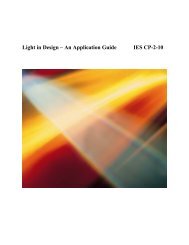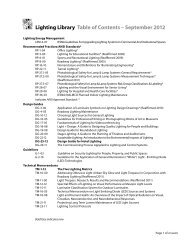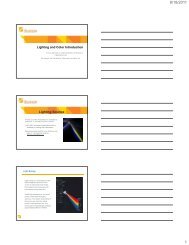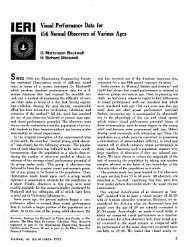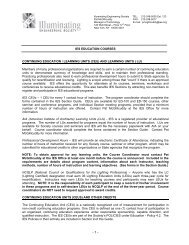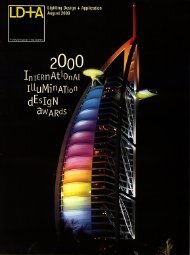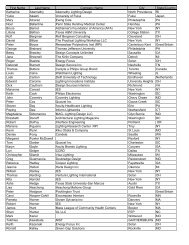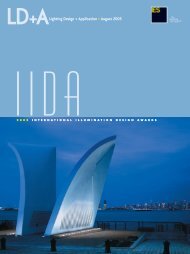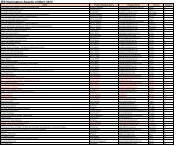lightfair international - Illuminating Engineering Society
lightfair international - Illuminating Engineering Society
lightfair international - Illuminating Engineering Society
Create successful ePaper yourself
Turn your PDF publications into a flip-book with our unique Google optimized e-Paper software.
is easier. Replacement lamp costs are<br />
about the same. For example, eight<br />
F32T8 lamps cost about the same as one<br />
400 W HPS or metal halide lamp.<br />
HID technology has not stood still. The<br />
most significant ongoing improvement<br />
is pulse start metal halide lamps and<br />
ballasts with ignitors to drive them. This<br />
system provides substantial gains in lm/W,<br />
lumen maintenance, color stability,<br />
shorter warm up times, shorter restrike<br />
times, and minimum ambient temperature<br />
starting. Lamp life can also be extended.<br />
This system could replace standard<br />
metal halide and HPS. Currently there is<br />
a price premium, but much of that could<br />
evaporate down the road.<br />
There are other HID improvements,<br />
such as energy saving lamps, extended<br />
life lamps, double arc tube lamps, high<br />
CRI, electronic ballasts, two stage (highlow)<br />
systems with occupancy sensors<br />
and/or photocontrols, and fixtures with<br />
quartz backup, but most of these<br />
upgrades are quite expensive. Some<br />
have drawbacks. An example is color corrected<br />
HPS lamps that have much better<br />
color rendering, but also higher cost,<br />
reduced light output, and shorter lamp<br />
life. Electronic HID ballasts consume less<br />
wattage than magnetic HID ballasts, but<br />
HID lamps draw the same wattage either<br />
way. Although the two stage systems for<br />
HID do reduce power at low stage, it<br />
is not linear. At 50 percent light output,<br />
wattage is considerably higher than 50<br />
percent often in the 60–70 percent range.<br />
Better Way To Measure Light<br />
The long established way of measuring<br />
the amount of light a source produces<br />
has been the photopic lumen. The<br />
lumens listed in lamp catalogs are photopic<br />
lumens. It is very easy to perceive<br />
that photopic lumens are not realistic.<br />
Following are two examples.<br />
Compare 14,000 photopic lumens<br />
175 W, 65 CRI standard metal halide<br />
with 16,000 photopic lumens 150 W,<br />
22 CRI standard HPS. Metal halide and<br />
HPS are the two most common types of<br />
HID. Although the metal halide has<br />
slightly less photopic lumens, virtually<br />
everyone perceives that it is brighter<br />
than the higher photopic output HPS.<br />
Another example is four various color<br />
tone fluorescent lamps with not only<br />
almost identical photopic lumens but<br />
also identical CRI. When an F32T8<br />
830, F32T8 835, F32T8 841, and<br />
F32T8 850 lamp are compared, almost<br />
everyone perceives the 850 lamp the<br />
brightest, followed by the 841 lamp,<br />
the 835, and the 830 lamp the least<br />
bright.<br />
With the substantial inconsistency<br />
between photopic lumens and general<br />
perception, we no longer base lighting<br />
recommendations on just photopic lumens<br />
or light meter measurements. Things got<br />
more scientific after we stumbled on Sam<br />
Berman’s work on pupil lumens (later<br />
called task modified lumens) all beautifully<br />
explained in his and Brian Liebel’s<br />
“Essay By Invitation” in the November<br />
1996 LD+A. 1<br />
Photopic lumens are based on the<br />
eye’s two degree central field of vision.<br />
This is only 0.02 percent of the human<br />
total visual field. There are two types of<br />
photoreceptors: cones and rods. In this<br />
two degree central field of vision, cones<br />
are the main photoreceptors and photopic<br />
lumens are based on cone sensitivity.<br />
Rods, which greatly outnumber cones,<br />
are excluded in photopic lumens. The<br />
peak sensitivity for rods is in the bluegreen<br />
region of the spectrum, compared<br />
to green-yellow for cones. Scopotic<br />
lumens are based on rod sensitivity.<br />
Both cones and rods contribute to how<br />
the eye perceives light for daytime tasks.<br />
S/P (scotopic/photopic ratios) can be<br />
used as a tool to show how the human<br />
eye really sees. Page 79 of the 1996<br />
Philips Lighting’s Lamp Specification<br />
and Application Guide has S/P ratios<br />
for many fluorescent lamps, including<br />
1.83 S/P for F32T8 850 and 1.62 S/P<br />
for F32T8 841. In addition to that listing,<br />
standard 40K clear metal halide has<br />
1.49 S/P, standard HPS has 0.62 S/P,<br />
and low pressure sodium has 0.40 S/P.<br />
For the vast majority of applications the<br />
higher the ratio the better.<br />
Berman and Liebel listed three task<br />
application factors for various tasks. For<br />
general evaluation we tend to use the 0.78<br />
exponent, where good vision is a requirement.<br />
photopic lumens x (S/P) 0.78 = initial<br />
task modified lumens<br />
We believe that worst case, when lamps<br />
are old, is more relevant, so we include<br />
lumen maintenance in the equation.<br />
photopic lumens x (S/P) 0.78 x<br />
lumen maintenance = end-of-life task<br />
modified lumens<br />
Generic composites of a variety of<br />
lamp and ballast combinations are<br />
shown in Table 1.<br />
Recent Applications<br />
Contra Costa Newspapers, Walnut<br />
Creek, CA<br />
Circle 13 on Reader Service Card.



